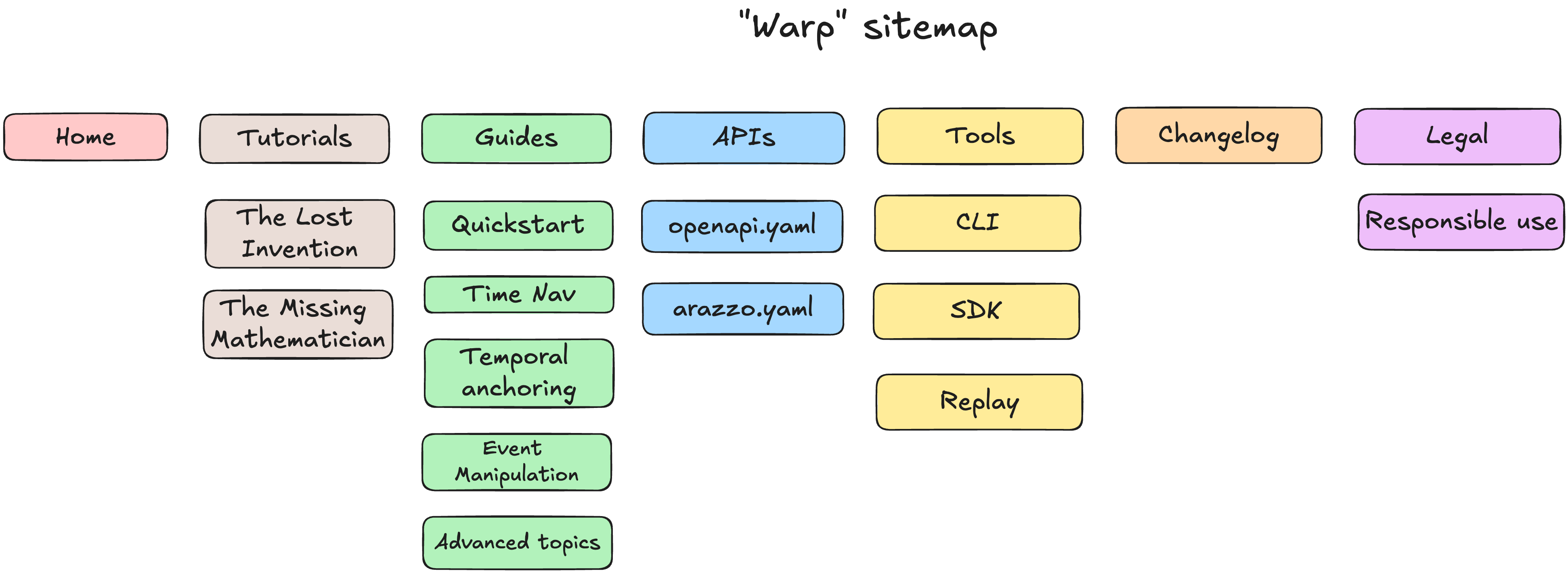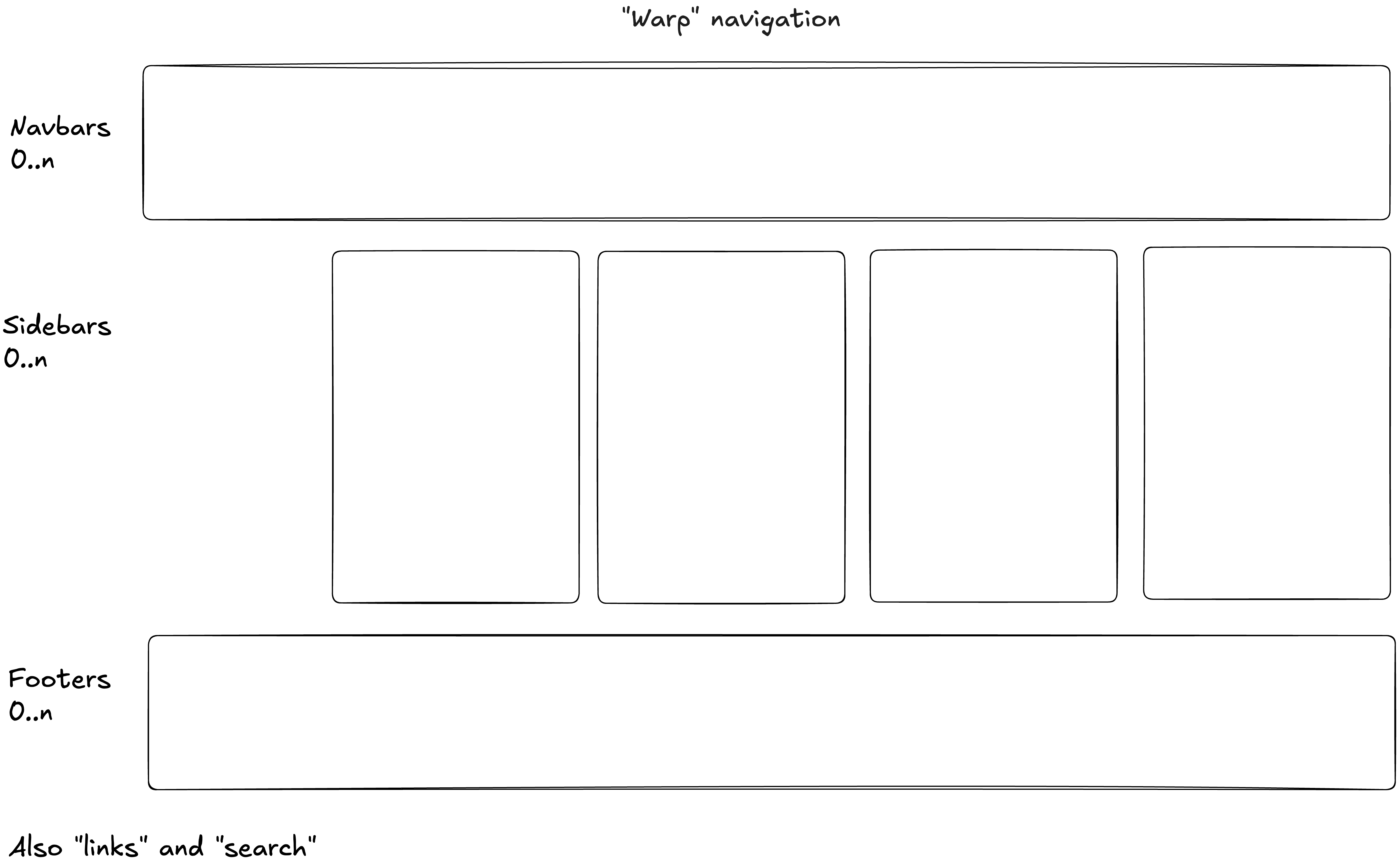About this template: Warp single-sidebars
Redocly offers almost complete flexibility in information architecture. This website is a demonstration of a common information architecture with a single navbar and multiple sidebars.
The content is meant to be fun and playful, but the information architecture is serious.
Step 1: Sitemap
Map your content out. A sitemap is different from navigation.
I color code the sitemap to organize the content into logical groupings.

To spare space, I only show the handful of pages in each logical grouping.
Step 2: Navigation
Decide how you want to organize your navigation. You can have navbars, sidebars, and footers. Most websites have 1 navbar and 1 footer, but it's not uncommon to have multiple sidebars. In some exceptions for multi-product website, they have multiple navbars.

I decided this site would have 1 navbar, 1 footer, and a single sidebar. I decided a few pages shouldn't have sidebars such as the home page, and the legal pages.
However, I could have added a sidebar to any of those pages by adding the file to the appropriate sidebars.yaml file.
A project with multiple sidebars would have multiple sidebars.yaml files (with that exact name but located in different folders). They can be organized into folders as appropriate. See an example with multiple sidebars on GitHub.
This project with a single sidebar is also available on GitHub at the Warp Single-sidebar template.
├──@theme
│ ├──Templates
│ │ └──StepByStep.tsx
│ ├──components
│ │ └──CardWithCode
│ │ └──CardWithCode.tsx
│ ├──markdoc
│ │ ├──components.tsx
│ │ └──schema.ts
│ └──styles.css
├──about.md
├──apis
│ ├──arazzo.yaml
│ └──index.yaml
├──changelog.md
├──guides
│ ├──advanced-topics
│ │ ├──automated-event-manipulation.md
│ │ ├──case-studies-advanced-manipulation.md
│ │ ├──complex-paradox-resolution.md
│ │ ├──custom-extensions-plugins.md
│ │ ├──high-precision-temporal-anchoring.md
│ │ ├──index.md
│ │ ├──multi-timeline-management.md
│ │ ├──security-in-time-travel.md
│ │ ├──temporal-data-management.md
│ │ ├──temporal-ethics-best-practices.md
│ │ └──temporal-mechanics.md
│ ├──event-manipulation.md
│ ├──index.md
│ ├──quickstart.md
│ ├──temporal-anchoring.md
│ └──time-navigation.md
├──images
│ ├──background.svg
│ ├──grid-dark.svg
│ ├──grid.svg
│ ├──logo.svg
│ ├──navigation.png
│ └──sitemap.png
├──index.page.tsx
├──legal
│ ├──responsible-use.md
│ └──terms.md
├──package-lock.json
├──package.json
├──redocly.yaml
├──sidebars.yaml
├──tools
│ ├──cli.md
│ ├──index.md
│ ├──replay.md
│ └──sdks.md
└──tutorials
├──index.md
├──lost-invention.md
└──missing-mathematician.mdStep 3: Home page
The home page is the first page that visitors see. It is the most important page.
While I usually start with a draft, I often complete the home page last.
The home page can have a hero section, a features section, a benefits section, and a call to action.
In addition, the home page can have a navbar, a footer, and a sidebar. However, many times people choose not to have a sidebar on the home page.
I start my home page in Markdown because it's easy to write. Then, I add in the fancier components and design flourishes last.
The same concept applies to any landing page, not just the home page.
About Papr Memory API
The Papr Memory API is a powerful solution for building AI applications with infinite memory and context awareness. Our API enables developers to create sophisticated AI experiences across various industries, from customer support to specialized domains like healthcare and legal tech.
Core Technology
At the heart of Papr Memory API is our state-of-the-art retrieval technology, achieving 86% accuracy on the STARK benchmark. This industry-leading performance enables:
- Precise context matching across large knowledge bases
- Dynamic relationship mapping between different pieces of information
- Automatic organization and categorization of knowledge
- Seamless integration with popular AI platforms
Key Features
Rich Memory Management
- Store and organize memories with metadata, tags, and context
- Support for various content types including text, documents, and conversations
- Automatic content extraction and processing
- Hierarchical knowledge organization
Advanced Retrieval
- State-of-the-art semantic search capabilities
- Context-aware memory retrieval
- Relevance scoring and ranking
- Real-time memory updates
Enterprise Ready
- Multi-tenant architecture
- Role-based access control
- Comprehensive security features
- Compliance with industry standards
Developer Experience
- Comprehensive SDKs for popular languages
- Detailed documentation and tutorials
- Active developer community
- Dedicated support team
Getting Started
- Sign up for an API key at app.papr.ai
- Follow our Quickstart Guide
- Explore our Tutorials
- Join our Developer Community
Support
We're here to help you build amazing AI applications:
- Documentation: docs.papr.ai
- Community: community.papr.ai
- Email: support@papr.ai
- Twitter: @papr_ai
Security and Compliance
Papr Memory API is built with security and privacy in mind:
- SOC 2 Type II certified
- GDPR compliant
- HIPAA compliant (with BAA)
- Regular security audits
- Data encryption at rest and in transit
Pricing
We offer flexible pricing plans to suit different needs:
- Developer - Perfect for testing and small projects
- Business - For growing companies and teams
- Enterprise - Custom solutions for large organizations
Visit our pricing page for more details.
Updates and Roadmap
Stay updated with our latest features and improvements:
Contributing
We welcome contributions from the community: